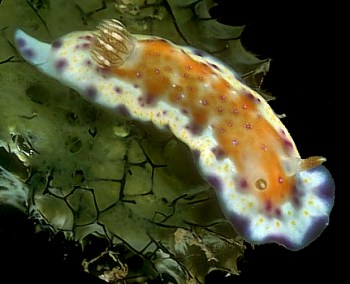
Chromodoris collingwoodi
Rudman, 1987
Order: NUDIBRANCHIA
Suborder: DORIDINA
Superfamily: EUDORIDOIDEA
Family: Chromodorididae
DISTRIBUTION
Western Pacific.
PHOTO
UPPER RIGHT: Split Solitary Is., 15m, off Coffs Harbour, NSW, Australia, March 1988, on food sponge. 17mm long alive.
LOWER: A, Récif de l'Infernet, in lagoon, off Koumac, New Caledonia, 20°35.8'S, 164°12.7'E, 9 m, inner side of reef, 15 October 1993, 38mm long alive. B,C. Récif de l'Infernet, in lagoon, off Koumac, New Caledonia, 20°37.1'S, 164°14.7'E, 1 m, diverse substrate, 22 October 1993, 2 specimens (23 & 44mm long alive).
PHOTOS: Bill Rudman.
The mantle has a purple border of irregular width. Inside this is a broad white region surrounding a large central translucent reddish or orange-brown patch extending from in front of the rhinophores to just behind the gills. There are many bright yellow spots scattered over the outer half of the white region. Also in the white region are dark purple spots, usually larger than the yellow ones but not always, and they are more numerous on the inner half. The dark spots are found not only in the white region but also in the central region where they are obscured by the orange-brown
pigmentation and appear as shadowy brown regions. One characteristic feature of the central brown region is the scattering of fine white specks all over. In some specimens in which parts of the red-brown region are very pale, the white specks are concentrated over the shadowy brown spots. There is considerable variation in the intensity of the reddish brown central patch as can be seen in the photos on this page.
The rhinophore stalk is translucent and the club is a dark reddish brown with white specks along the edge of the lamellae and a white tip. The gills are sub-quadrangular in section. They are translucent with a dark brown, almost black, line down the two edges of each of the outer and inner sides, the pigmentation extending a little out on to both sides of the gill lamellae.
The underside of the mantle is white with a purple edge, as dorsally, and there is a purple spot on each oral tentacle. The foot is white with a row of bright yellow spots all around the edge. Posteriorly there are some purple patches and sometimes more widespread yellow spots.
This species has been confused with C. aureopurpurea Collingwood. In fact it differs markedly in colour from C. aureopurpurea, in which the mantle is white with yellow spots, except at the edge, where there is a submarginal row of dark purple spots and a diffuse purple band right at the edge. In C. collingwoodi there is an irregular purple border and then a broad region in which there are small yellow and larger purple spots. The central part of the mantle is usually a translucent red- brown with brownish spots and fine white specks. Another species with a similar colour pattern is C. tennentana. In that species the border is bluish purple and the white region inside it has yellow spots. It has a large orange-brown central patch as in C. collingwoodi but differs in having large purple spots each surrounded by a white ring and these are restricted to the central part of the mantle with an orange-brown background colour.
Reference:
•Rudman, W.B. (1987) The Chromodorididae (Opisthobranchia: Mollusca) of the Indo-West Pacific: Chromodoris epicuria, C. aureopurpurea, C. annulata, C. coi and Risbecia tryoni colour groups. Zoological Journal of the Linnean Society, 90: 305-407.
PHOTOS: LOWER: A, Récif de l'Infernet, in lagoon, off Koumac, New Caledonia, 20°35.8'S, 164°12.7'E, 9 m, inner side of reef, 15 October 1993, 38mm long alive.
B,C. Récif de l'Infernet, in lagoon, off Koumac, New Caledonia, 20°37.1'S, 164°14.7'E, 1 m, diverse substrate, 22 October 1993, 2 specimens (23 & 44mm long alive).
PHOTOS: Bill Rudman.
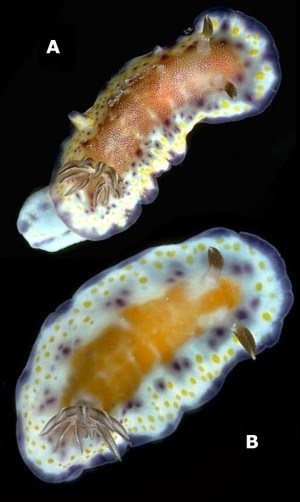
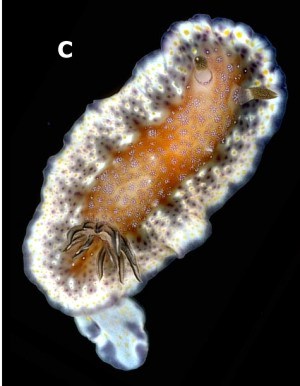
Rudman, W.B., 2000 (May 21) Chromodoris collingwoodi Rudman, 1987. [In] Sea Slug Forum. Australian Museum, Sydney. Available from http://www.seaslugforum.net/find/chrocoll
Related messages
Chromodoris collingwoodi feeding & breeding
March 23, 2010
From: Leanne and David Atkinson
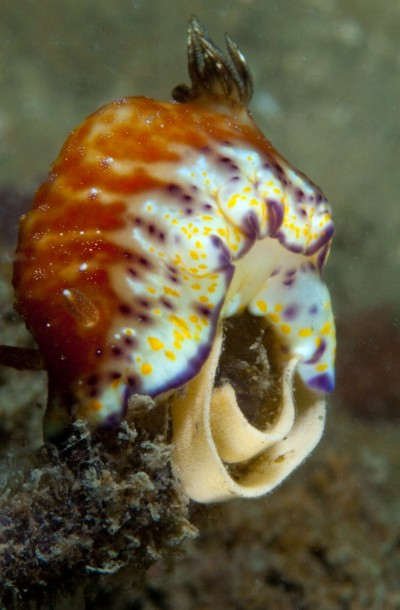
Concerning message #15530:
Dear Bill,
David found an aggregation of feeding Chromodoris collingwoodi. I found one laying eggs on an ascidian beside the sponge where the rest of the group were feeding. These photos actually show the nudibranch using its foot to shape the rosette of eggs and the eggs being extruded.
Locality: Seahorse Gardens, Nelson Bay Beach, Port Stephens, 8metres, New South Wales, Australia, Pacific Ocean, 21 March 2010, Sandy bottom with scattered sponges, bryozoans, ascidians, soft corals, Sea Pens and gorgonias. Length: 40 mm. Photographer: Leanne and David Atkinson.
Hope they are of interest.
Leanne and David Atkinson
atk@hunterlink.net.au



Dear Leanne and David,
Thanks for another valuable set of photos. The more I see of chromodorids the more I feel that breeding aggregations usually begin as feeding aggregations. This may not be the case with herbivores such as the Sea Hares but if someone began a detailed survey of chromodorid aggregations I wouldn't mind betting that food would be the common factor.
It is good to get another record of this blue Dictyodendrilla sp. which appears to be the usual, perhaps only, food choice of this species.
Best wishes,
Bill Rudman
Re: Chromodoris collingwoodi feeding observations
June 21, 2007
From: Bruce Wilkie
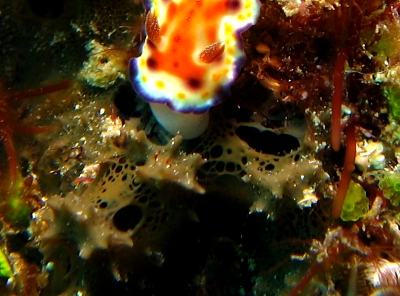
Concerning message #19356:
Hi Bill,
Here is another feeding record of Chromodoris collingwoodi for the forum.
Locality: Flat rock, Point lookout, Nth Stradbroke island, 12mts, Queensland, Australia. , Pacific ocean., 30 May 2007, Rocky reef, hard and soft corals, sponges.. Length: 30mm. Photographer: Bruce Wilkie
Many thanks,
Bruce Wilkie.
brucedwilkie@yahoo.com.au
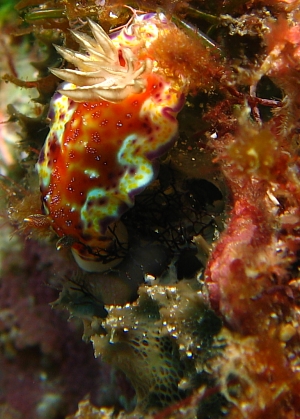
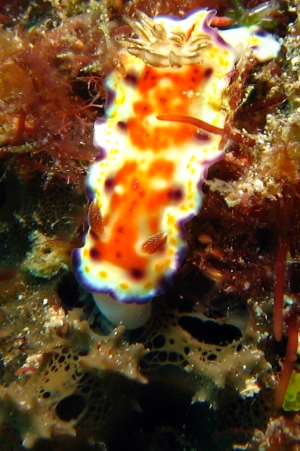
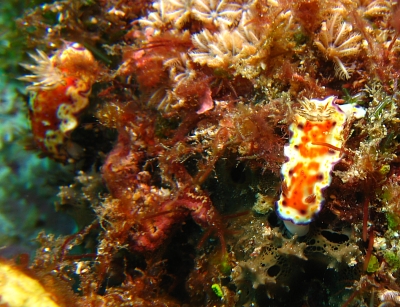
Dear Bruce,
Thanks very much. As you know, my chromodorid feeding review is due to be published any day now, but I knew that it would only be 'part 1' because I have at least 5 new records to add and now yours. Publication is always an interesting stage in research because now the world can test your hypotheses and observations. Until now, the only sponge genera we have found C. collingwoodi eating is Dictyodendrilla, and this appears to be what they are eating in your photos.
In the photo alongside we can see that both animals are quite far apart but the close-ups above show they are both feeding on the same sponge. This again illustrates how huge sponge colonies can be almost completely covered or obscured by algal growths, hydroids and other animals, making prey identification of sponge-feeding nudibranchs very difficult. Thanks Bruce for your diligent searching, it is helping to fill in many gaps in our knowledge.
Best wishes,
Bill Rudman
Chromodoris collingwoodi feeding observations
January 31, 2007
From: Leanne & David Atkinson
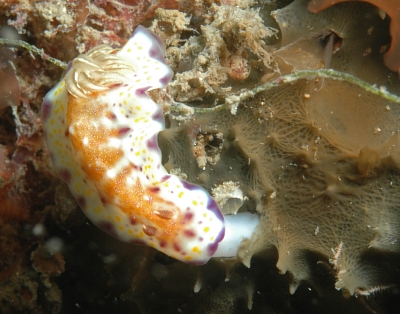
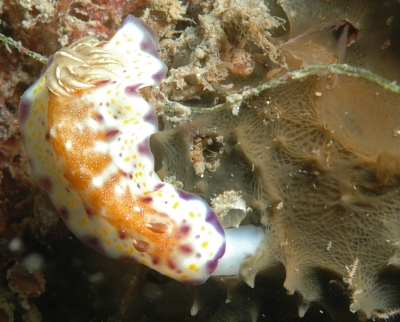
Dear Bill,
We came across this Chromodoris collingwoodi feeding on a brown sponge that looks similar to the black sponge that we have seen it feeding on before. Thought this may be of interest.
Locality: The Pipeline, Port Stephens , 8 metres, New South Wales, Australia, Pacific, 20 January 2007, Silty, sandy bottom with scattered sponges, ascidians, soft corals and bryozoans. Length: 80 mm. Photographer: Leanne & David Atkinson.
Regards,
Leanne & David Atkinson
atk@hunterlink.net.au
Atkinson, L. & D., 2007 (Jan 31) Chromodoris collingwoodi feeding observations. [Message in] Sea Slug Forum. Australian Museum, Sydney. Available from http://www.seaslugforum.net/find/19356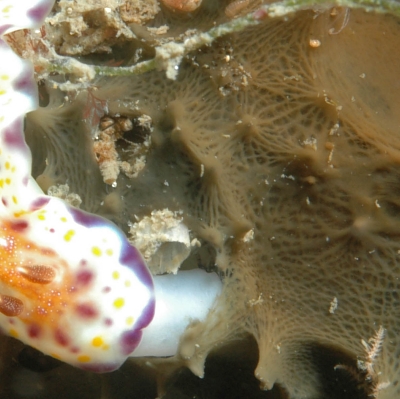
Dear Leanne & David,
Thanks for another valuable record. I am not sure if it is the same species as the dark bluish sponge you have found it feeding on before but this sponge is certainly of the same genus - Dictyodendrilla.
Some of you may have noticed I have been a bit slow answering messages over the last 2-3 weeks. The reason is that my sponge expert has been in town and I tried to put most things to one side so we could finally complete the manuscript I have been working on for a couple of years, on sponge specificity in the chromodorids - which we have done. Hopefully it won't be too long before it is published. Don't think I am now no longer interested in feeding observations however. Although we have a nice story to tell, we now need even more observations to test our conclusions.
Best wishes,
Bill Rudman
Chromodoris collingwoodi laying eggs
January 12, 2006
From: Leanne & David Atkinson
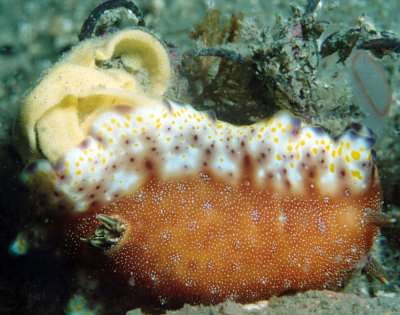
Dear Bill,
Here is a shot of Chromodoris collingwoodi laying eggs. It was squeezed in between the growth it was laying on and its black food sponge so was hard to get a clear shot of. The foot is shaping the eggs as it is laying. Much to our frustration we were at the end of the film. This was right on top of the pipe rather than in the sponge or soft coral gardens stretching out to the side.
Locality: The Pipeline, Port Stephens, NSW Australia.: Depth: 8 m. Length: approximately 60 mm. 08 January 2006. Sandy bottom with sponges, ascidians and soft corals. Photographer: Leanne & David Atkinson
Regards,
Leanne & David Atkinson
atk@hunterlink.net.au
Atkinson, L. & D., 2006 (Jan 12) Chromodoris collingwoodi laying eggs. [Message in] Sea Slug Forum. Australian Museum, Sydney. Available from http://www.seaslugforum.net/find/15530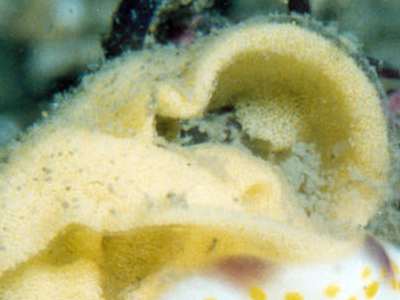
Dear Leanne & David,
Thanks for this photo. It certainly fits with Nerida Wilson's earlier message [#12246] so it's nice to have some confirmation. When I first looked at your photo I thought I could see darker yellow specks of extracapsular yolk but on closer examination I think I was imagining it.
Best wishes,
Bill Rudman
Chromodoris collingwoodi from sthrn Queensland
August 10, 2004
From: Gary Cobb
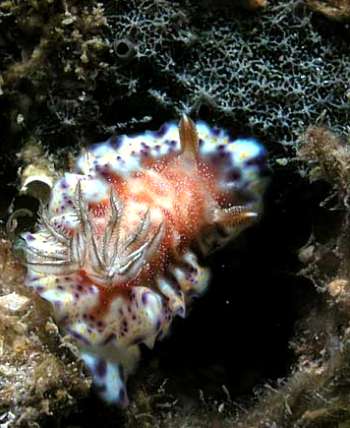
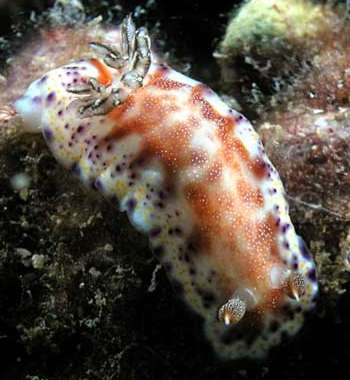
Hi Bill,
Please find attached 3 photos of Chromodoris collingwoodi found at Old Woman Island, Sunshine Coast, Queensland, Australia. Size 25mm. The animal was eating a black sponge. The colour are beautiful.
If you are interested I have started about a year ago recording all species on the Sunshine Coast. The area of interest is central Moreton Island up to Noosa. All the recordings are at my website http://www.nudibranch.com.au/. To date I and my dive buddy David Mullins have found 93 species. I have included on the site the locations and occurances of the animals. As well as maps of the areas. The Coast hold many surprises every time we go diving.
Thanks,
Gary
gary@cobb.com.au
Cobb, G., 2004 (Aug 10) Chromodoris collingwoodi from sthrn Queensland. [Message in] Sea Slug Forum. Australian Museum, Sydney. Available from http://www.seaslugforum.net/find/12382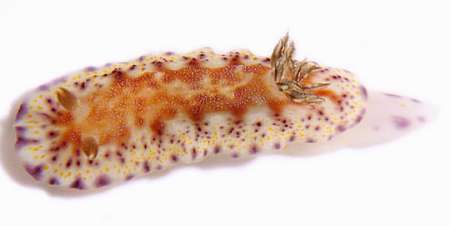
Thanks Garym
Sorry it's taken me a while to post this message of yours but as you understand I am having some difficulties. I am glad to see another record of this animal on its preferred sponge. Good Luck with your website
Best wishes
Bill Rudman
Chromodoris collingwoodi egg mass
February 19, 2004
From: Nerida Wilson
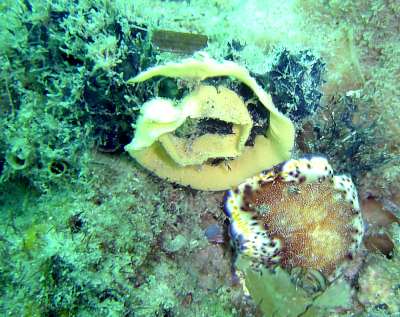
Hi Bill,
Here is a photo of Chromodoris collingwoodi from Moreton Bay, Queensland (~12m). I noticed a few small specimens feeding on the dark sponge in November 2003. This photo was taken in January 2004 after they had grown quite a bit, and conveniently shows food sponge and upright egg mass. I have never seen it feeding on any other sponge.
cheers
Nerida
nwilson@marine.uq.edu.au
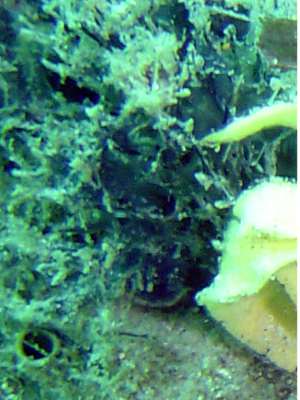
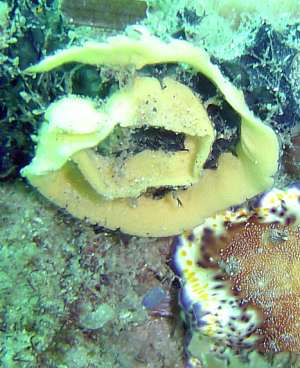
Thanks Nerida,
With recent messages [#12184] we certainly a getting a good picture of this species
Best wishes
Bill Rudman
Chromodoris collingwoodi feeding
February 17, 2004
From: Leanne & David Atkinson
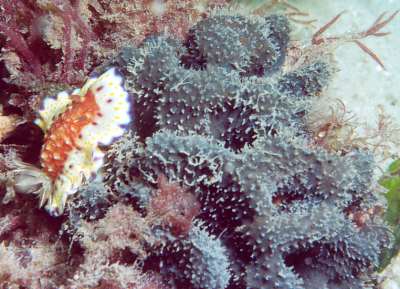
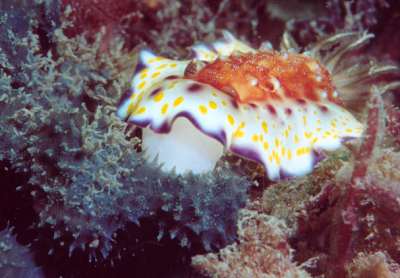
Dear Bill,
We found Chromodoris collingwoodi feeding on this black sponge again. These are better photos than the first lot we sent in [message #11886].
Date: 07.02.04
Location: Fly Point, Marine Reserve, Port Stephens, NSW, Australia
Time: 10:00am Tide: High 1.77m
Depth: 6m Water Temp: 18 degrees celcius
Hope this is of interest,
Leanne & David Atkinson
atk@hunterlink.net.au
Atkinson, D.& L., 2004 (Feb 17) Chromodoris collingwoodi feeding. [Message in] Sea Slug Forum. Australian Museum, Sydney. Available from http://www.seaslugforum.net/find/12184Dear Leanne & David
Thanks for this. At present the sponge has tentatively been identified as a species of Dictyodendrilla. Hopefully with these photos I should be able to get a species name for it, if one exists.
Best wishes
Bill Rudman
Chromodoris collingwoodi feeding
January 15, 2004
From: Leanne & David Atkinson
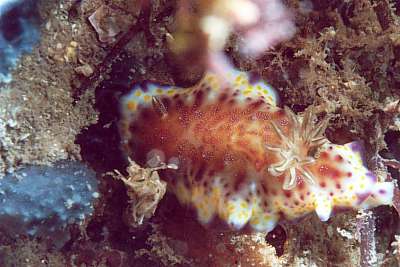
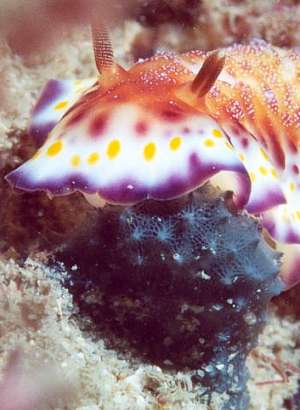
Dear Bill,
The following photographs show Chromodoris collingwoodi feeding on a dark grey or black spnge. The first photo shows it in the head down position I found it in. It wasn't a good angle so I moved it and noticed that the mouth parts had been extended. We then placed it beside the sponge and it crawled back extending its mouth. You can see the mouth in shots 2 and 3. You already have some good shots of it feeding on the site. These are from a different location. Hope they are of interest.
Date: 28 December 2003
Locality: Fly Point, Marine Reserve, Port Stephens, NSW, Australia.
Time: 1:30pm Tide: High, 1.6m
Depth: 8m
Length:60mm
Thanks for your help,
Yours sincerely,
Leanne & David Atkinson
atk@hunterlink.net.au
Atkinson, L. & D., 2004 (Jan 15) Chromodoris collingwoodi feeding. [Message in] Sea Slug Forum. Australian Museum, Sydney. Available from http://www.seaslugforum.net/find/11886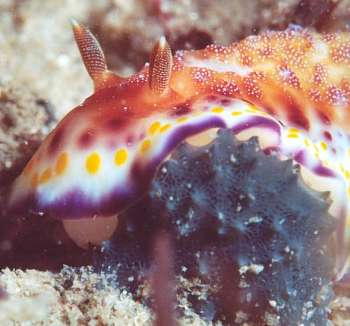
Dear Leanne & David,
We have not yet reached the stage where we have too many photos showing feeding. In fact of those for this species yours are the only ones where the sponge structure is probably clear enough for a positive identification.
Best wishes
Bill Rudman
Re: Chromodoris collingwoodi from South China
October 16, 2003
From: Mabel Fang
Dear Bill
Thank you for your wonderful and prompt assistance. To add further insight to the dive location, I have included some additional information.
'7 Skies' is a shipping tanker which sank in the late 1960s after some explosions on board. The wreck is still intact and sits upright on the seabed at about 170 feet. The top of the wreck which is essentially the bridge tower, is around 110 feet. The wreck is now encrusted with a kaleidoscope of soft coral. '7 Skies' draws many weekend liveaboard divers with the promise of pelagic sightings. It certainly lived up to the promise as a whale shark, manta ray and schools of barracuda decided to pay us a visit on that day. We were pleasantly surprised when in-between all the 'big game' action, we stumbled upon the Chromodoris collingwoodi. The little fella was spotted at about 120 feet, on the bridge tower, and was less than 1 cm in length. On a less than perfect day, it would have been almost impossible to find the nudibranch, let alone photograph it because the divesite is usually washed by strong currents and bottom time is limited.
Best regards
Mabel Fang
barramundi@ooi-online.com
Fang, M., 2003 (Oct 16) Re: Chromodoris collingwoodi from South China. [Message in] Sea Slug Forum. Australian Museum, Sydney. Available from http://www.seaslugforum.net/find/11252Thanks Mabel,
Bill Rudman
Chromodoris collingwoodi from South China Sea
October 13, 2003
From: Mabel Fang
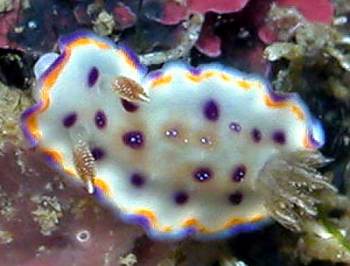
Hi Bill
Saw this nudi on 7-skies, a wreck in the South China Sea. We were all waiting for some big fish action when my buddy chanced upon it.
Date: 27 Sept 2003
Depth: 120feet
Size: 1 cm
Could you kindly ID it for me?
Thanks.
Mabel Fang
barramundi@ooi-online.com
Fang, M., 2003 (Oct 13) Chromodoris collingwoodi from South China Sea. [Message in] Sea Slug Forum. Australian Museum, Sydney. Available from http://www.seaslugforum.net/find/11211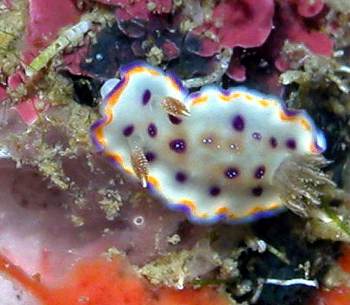
Dear Mabel.
This is an interesting find. It's an apparent colour form of Chromodoris collingwoodi which I have seen before. I haven't seen one with the yellow forming a broken submarginal line around the mantle edge. Usually there is a band of yellow spots. However the rest of the colour pattern clearly shows what it is.
Another interesting thing is the partially everted oral tube - the white lump at the front of the head - which shows that it is either feeding or has just been disturbed while feeding. I can't be sure if the dark grey-blue patch its head is on is a sponge or not, but it fits two other photos we have of this species feeding on a dark blue sponge [see message 1, message 1].
I see 7-Skies is a popular dive site in the South China Sea, east of Pulau Aur off the south east coast of the Malay Peninsula. If you can give me a little more than the name of a wreck in future, it would be helpful. I realise at the moment the wreck features prominently in the dive trips of a number of dive charter boats, but it doesn't appear on any normal maps.
Best wishes
Bill Rudman
Chromodoris collingwoodi from Port Stephens
June 13, 2003
From: Dave Harasti
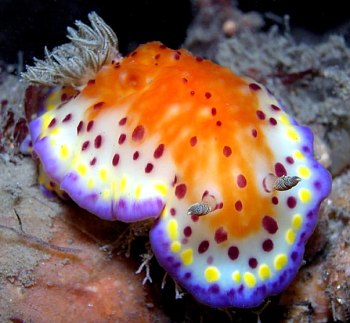
Hi Bill,
Here's a nice pic of Chromodoris collingwoodi from Little Beach - Nelson Bay, New South Wales, Australia. Taken in May 2003. Size 6cm.
Cheers,
Dave
diving@webone.com.au
Harasti, D., 2003 (Jun 13) Chromodoris collingwoodi from Port Stephens. [Message in] Sea Slug Forum. Australian Museum, Sydney. Available from http://www.seaslugforum.net/find/9920Thanks Dave,
It is a nice photo. This animal is quite variable in colour but the range we know have on the Forum shows how they all merge into one another
Best wishes,
Bill Rudman
Chromodoris collingwoodi from Bali
February 19, 2002
From: Stuart Hutchison
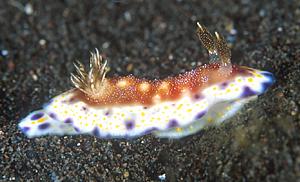
Bill,
Here is Chromodoris collingwoodi from Bali, Indonesia on 23 Oct 2001. Depth 8m, length 50mm.
It was the only C. collingwoodi we found in 90 dives at the site.
Stuart
stuart@stuarthutchison.com.au
Hutchison, S., 2002 (Feb 19) Chromodoris collingwoodi from Bali. [Message in] Sea Slug Forum. Australian Museum, Sydney. Available from http://www.seaslugforum.net/find/6279Thanks Stuart,
It's good to get an idea of the spread of the various colour forms.
Bill Rudman
Chromodoris collingwoodi from Hong Kong
July 13, 2001
From: Leslie Chan
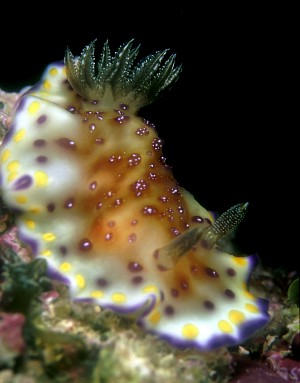
Dear Bill,
Could you identify this nudibranch which I photographed in Hong Kong.
Details: 11m, Tsim Chau, Hong Kong. 18 October 2000.
Thanks
Leslie Chan
leslie@lesmart.com
Chan, L., 2001 (Jul 13) Chromodoris collingwoodi from Hong Kong. [Message in] Sea Slug Forum. Australian Museum, Sydney. Available from http://www.seaslugforum.net/find/4762Dear Leslie,
This is Chromodoris collingwoodi. As I suggest in the accompanying message this colour form is the only one at present known from Hong Kong.
Best wishes,
Bill Rudman
Chromodoris collingwoodi from Hong Kong
July 13, 2001
From: Bill Rudman & Brian Darvell
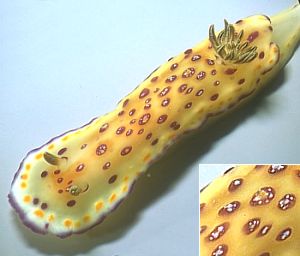
To accompany Leslie Chan's message, here is some information and photos on Chromodoris collingwoodi from Brian Darvell's Hong Kong collections. Hong Kong specimens appear to be characterized by the yellowish cream colour of the mantle with an irregular purplish border and a submarginal row of bright yellow spots. Inside the yellow spots are scattered, slightly raised brownish spots. Some of the more central brownish spots have clusters of small white specks. The rhinophore club is brown and the gills are edged with the same colour. In other parts of its range the brown spots are part of a much larger brown patch in the central part of the mantle. Grows to at least 40 mm long.
PHOTO: Lam Fung Chau, Hong Kong, 5m, 23 June 1984, Photo: B.W.Darvell.
Hong Kong Collection Records: AM C142330, 23 June 1984, Site 9.22, Green Is., Rocky Harbour (Lam Fung Chau), 5 m. Hong Kong.
Reference:
• Rudman, W.B. & Darvell, B.W. (1990) Opisthobranch molluscs of Hong Kong. Part 1. Goniodorididae, Onchidorididae, Triophidae, Gymnodorididae, Chromodorididae, (Nudibranchia). Asian Marine Biology, 7: 31-79
Best wishes,
Bill Rudman & Brian Darvell
Re: Chromodoris collingwoodi feeding
June 24, 2000
From: Jeff Goddard
Hi Bill,
Great photos by Mary Jane Adams of Chromodoris collingwoodi feeding on the black sponge, and I could not agree more with your comments about the value of these kinds of photos and locality information. Kudos to you for providing us all with such a fine venue for presenting information on our favorite creatures.
Regarding Mary Jane's bottom right photo. Are those spongin fibers protruding from the surface of the sponge? Is it possible to tell from your file of the image if that black sponge is an Aplysillid?
Best wishes,
Jeff
goddard@lifesci.ucsb.edu
Goddard, J., 2000 (Jun 24) Re: Chromodoris collingwoodi feeding. [Message in] Sea Slug Forum. Australian Museum, Sydney. Available from http://www.seaslugforum.net/find/2606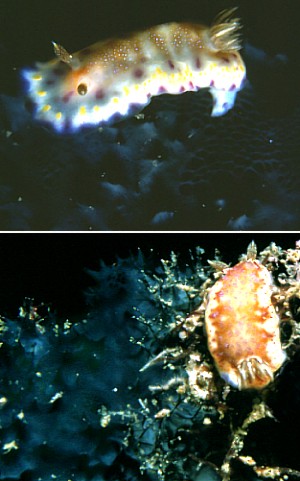
Dear Jeff,
There do appear to be spongin fibres protruding from the sponge body in Mary Jane's photo. I suspect it is an aplysillid but it's not one I have run past Pat Bergquist who kindly helps me with sponge identifications. Aplysillids and other sponges without spicules are particularly difficult to identify because the spicules provide a particularly useful set of characters. Unless aplysillids are well preserved, and sufficient samples are available, and colour photos are available they are impossible to identify. Sounds much like identifying a nudibranch doesn't it?
It is possible that the photo at the top of the page is a growth or colour form of the same sponge. I also have photos of C. collingwoodi on a dark blue sponge of similar shape. The UPPER photo is from Carol Buchanan and was taken in her aquarium od a specimens from the Solitary Ids, northern new South Wales, Australia, January, 1986. The LOWER photo is an unlabelled photo from the museum collection which I have kept because of the sponge connection.
Some species of chromodorid seem to be always found on their food sponges while others, like C. collingwoodi, need us to patiently accumulate information over a number of years.
Best wishes,
Bill Rudman.
Chromodoris collingwoodi feeding
June 22, 2000
From: Mary Jane Adams
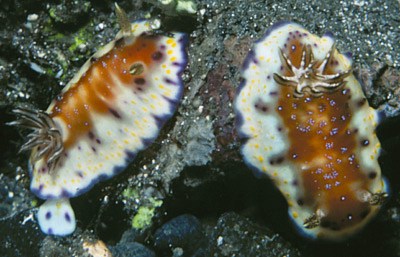
Dear Bill,
I found a pair of Chromodoris collingwoodi crawling around in a sandy bay with patch reef. When they came to some small black sponges they immediately began to feed, extending their mouths far beyond their mantles.
Length = 22mm, depth = 4 meters, Luadi, Milne Bay, Papua New Guinea, Nov. 24, 1995
Best regards,
Mary Jane
mjadams@earthlink.net
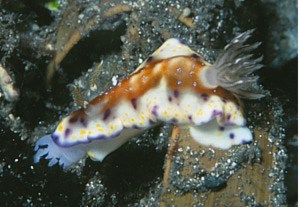
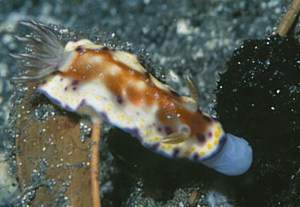
Dear Mary Jane,
Thanks very much for these photos. There can be no doubt that these animals are feeding. This is just the sort of valuable information that divers and amateur naturalists have but often don't realise its value. We know so little about the basic natural history of most sea slugs that a photograph like this is worth its weight in gold.
I know from talking to many visitors to the Forum who have never sent a message, that many of you feel hesitant to send messages and photos to the Forum because you are sure that what you have seen, or have a photo of, is common knowledge because you are not an expert. Nothing could be further from the truth. In this game everyone has the opportunity of being the expert on some aspect of even the most common sea slug's private life. So please, have a look at your photo collections and see if you have some photos which could be a scientific 'first'.
Best wishes,
Bill Rudman.
Chromodoris collingwoodi from Sydney
May 22, 2000
From: A. Lumnitzer & D. Piotrowska
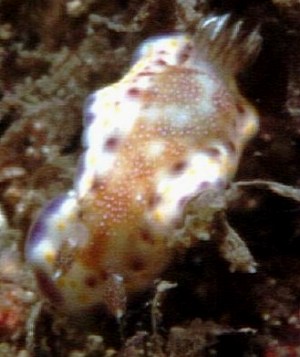
Dear Bill
Could you please ID this nudi for us if you wouldn't mind. Is it a species of Chromodoris? Perhaps it is a juvenile form of C.collingwoodi.
It is from Frenchmans Point, Botany Bay, Sydney, NSW in 13 meters.
Best wishes
Akos & Donata
akos72@hotmail.com
Lumnitzer, A. & Piotrowska, D., 2000 (May 22) Chromodoris collingwoodi from Sydney. [Message in] Sea Slug Forum. Australian Museum, Sydney. Available from http://www.seaslugforum.net/find/2427Dear Akos & Donata,
Your query has made me prepare another page for the Forum. Yes this is Chromodoris collingwoodi which seems to be a regular visitor, if not permanent resident, of the Sydney region. I the photos above you will see some of the colour variation found in the southwest Pacific. I am planning to add some materila from Hong Kong in the near future so I will then add a photo of another colour form from there.
Best wishes,
Bill Rudman.
